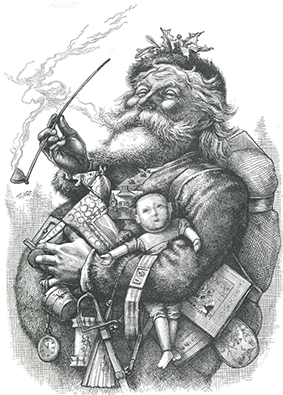
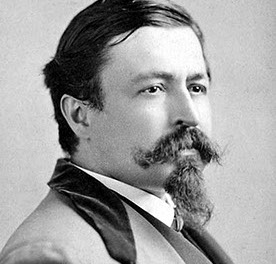
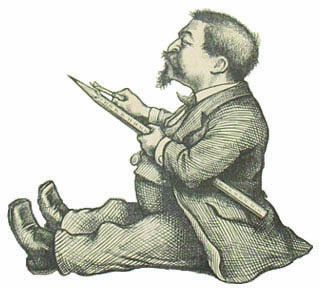
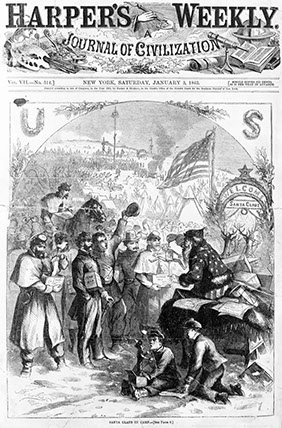
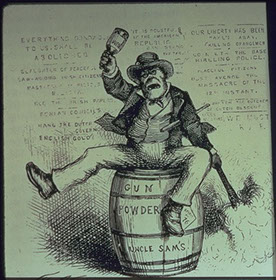
Thomas Nast
American Cartoonist
September 27, 1840 – December 7, 1902; was a German-born American caricaturist and editorial cartoonist often considered to be the "Father of the American Cartoon". He was a critic of Democratic Representative "Boss" Tweed and the Tammany Hall Democratic party political machine. Among his notable works were the creation of the modern version of Santa Claus (based on the traditional German figures of Sankt Nikolaus and Weihnachtsmann) and the political symbol of the elephant for the Republican Party (GOP). Nast was associated with the magazine Harper's Weekly from 1859 to 1860 and from 1862 until 1886.
In February 1860, he went to England for the New York Illustrated News to depict one of the major sporting events of the era, the prize fight between the American John C. Heenan and the English Thomas Sayers sponsored by George Wilkes, publisher of Wilkes' Spirit of the Times. A few months later, as artist for The Illustrated London News, he joined Garibaldi in Italy. Nast's cartoons and articles about the Garibaldi military campaign to unify Italy captured the popular imagination in the U.S. In February 1861, he arrived back in New York. In September of that year, he married Sarah Edwards, whom he had met two years earlier.
He left the New York Illustrated News to work again, briefly, for Frank Leslie's Illustrated News. In 1862, he became a staff illustrator for Harper's Weekly. In his first years with Harper's, Nast became known especially for compositions that appealed to the sentiment of the viewer. An example is "Christmas Eve" (1862), in which a wreath frames a scene of a soldier's praying wife and sleeping children at home; a second wreath frames the soldier seated by a campfire, gazing longingly at small pictures of his loved ones. One of his most celebrated cartoons was "Compromise with the South" (1864), directed against those in the North who opposed the prosecution of the American Civil War. He was known for drawing battlefields in border and southern states. These attracted great attention, and Nast was referred to by President Abraham Lincoln as "our best recruiting sergeant".
After the war, Nast strongly opposed the anti-Reconstruction policy of President Andrew Johnson, whom he depicted in a series of trenchant cartoons that marked "Nast's great beginning in the field of caricature".
The American River Ganges, a cartoon by Thomas Nast showing bishops attacking public schools, with connivance of "Boss" Tweed. Harper's Weekly, September 30, 1871.
Nast's cartoons frequently had numerous sidebars and panels with intricate subplots to the main cartoon. A Sunday feature could provide hours of entertainment and highlight social causes. After 1870, Nast favored simpler compositions featuring a strong central image. He based his likenesses on photographs.
In the early part of his career, Nast used a brush and ink wash technique to draw tonal renderings onto the wood blocks that would be carved into printing blocks by staff engravers. The bold cross-hatching that characterized Nast's mature style resulted from a change in his method that began with a cartoon of June 26, 1869, which Nast drew onto the wood block using a pencil, so that the engraver was guided by Nast's linework. This change of style was influenced by the work of the English illustrator John Tenniel. A recurring theme in Nast's cartoons is anti-Catholicism.
Nast was baptized a Catholic at the Saint Maria Catholic Church in Landau, and for a time received Catholic education in New York City. When Nast converted to Protestantism remains unclear, but his conversion was likely formalized upon his marriage in 1861. (The family were practicing Episcopalians at St. Peter's in Morristown.) Nast considered the Catholic Church to be a threat to American values. According to his biographer, Fiona Deans Halloran, Nast was "intensely opposed to the encroachment of Catholic ideas into public education". When Tammany Hall proposed a new tax to support parochial Catholic schools, he was outraged. His savage 1871 cartoon "The American River Ganges", depicts Catholic bishops, guided by Rome, as crocodiles moving in to attack American school children as Irish politicians prevent their escape. He portrayed public support for religious education as a threat to democratic government. The authoritarian papacy in Rome, ignorant Irish Americans, and corrupt politicians at Tammany Hall figured prominently in his work. Nast favored nonsectarian public education that mitigated differences of religion and ethnicity. However, in 1871 Nast and Harper's Weekly supported the Republican-dominated board of education in Long Island in requiring students to hear passages from the King James Bible, and his educational cartoons sought to raise anti-Catholic and anti-Irish fervor among Republicans and independents.
Nast expressed anti-Irish sentiment by depicting them as violent drunks. He used Irish people as a symbol of mob violence, machine politics, and the exploitation of immigrants by political bosses. Nast's emphasis on Irish violence may have originated in scenes he witnessed in his youth. Nast was physically small and had experienced bullying as a child In the neighborhood in which he grew up, acts of violence by the Irish against black Americans were commonplace.
In 1863, he witnessed the New York City draft riots in which a mob composed mainly of Irish immigrants burned the Colored Orphan Asylum to the ground. His experiences may explain his sympathy for black Americans and his "antipathy to what he perceived as the brutish, uncontrollable Irish thug". An 1876 Nast cartoon combined a caricature of Charles Francis Adams Sr with anti-Irish sentiment and anti-Fenianship.
In general, his political cartoons supported American Indians and Chinese Americans. He advocated the abolition of slavery, opposed racial segregation, and deplored the violence of the Ku Klux Klan. In one of his more famous cartoons, the phrase "Worse than Slavery" is printed on a coat of arms depicting a despondent black family holding their dead child; in the background is a lynching and a schoolhouse destroyed by arson. Two members of the Ku Klux Klan and White League, paramilitary insurgent groups in the Reconstruction-era South, shake hands in their mutually destructive work against black Americans.
HOME PAGE
Courtesy of Wikipedia®
Information last edited on 21 January 2023

